Migration (Inter-Regional, Intraregional & International) & Associated Problems | Geography Optional for UPSC PDF Download
Migration in India
- The study of population migration is crucial in understanding the dynamics of a society, particularly in a large country like India. As the country undergoes rapid economic development in areas such as manufacturing, information technology, and services, analyzing the migration profile of the population has become increasingly important.
- In the context of the Indian census, a person is considered a migrant if they are enumerated at a place different from their place of birth. This could be due to reasons such as marriage, which is the most common reason for female migration, or work, which is generally the case among males.
- Migration data in India is primarily derived from census data. Until the 1961 census, migratory data was collected with respect to "birthplace." The 1971 census incorporated migration by the last place of residence, and since the 1981 census, the causes of migration have been included in the data collection process. To account for minor migratory movements that may be overlooked in the 10-year gap between censuses, data from the National Sample Survey Office (NSSO) is also used to analyze migratory trends.
- According to census data, 25% of India's population migrates, with rural dwellers showing a higher tendency to migrate than their urban counterparts. The main cause of migration in India is economic. The census identifies seven broad reasons for migration: business, work and employment, marriage, moving at birth (children moving with parents), moving with families (dependents moving with employed individuals), political reasons (such as forced migration due to ethnic, tribal, or religious conflicts, and displacement due to development projects), and education.
- In recent times, in-migration to India has primarily been due to political refugees (from countries like Bangladesh and Tibet). Out-migration from India has occurred in four major instances: indentured labor, migration to Europe and the USA (mainly professionals), the partition of India, and the present phase (professionals in the IT sector).
- However, the majority of migration in India is internal, as Indians are considered among the least mobile people globally. In every census, 90% of people are enumerated in the same district as their place of birth, and only 7% were born in a neighboring district. Factors contributing to this low mobility include the family system, agrarian culture, widespread poverty, inadequate transportation and communication infrastructure, and limited knowledge about opportunities outside their immediate vicinity.
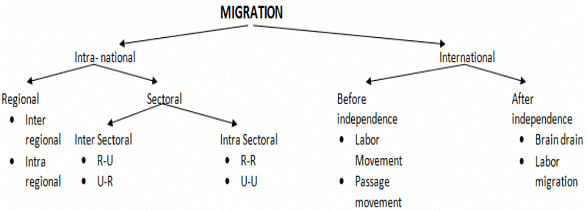
Internal Migration
- Internal migration refers to the movement of people within a country, from one defined area to another. It can be classified into two types: inter-regional migration, which involves moving from one region of the country to another, and intra-regional migration, where people move within the same region, such as from rural to urban areas or vice versa.
- In India, internal migration can be categorized into long-term migration, where an individual or household relocates permanently, and short-term migration, which involves temporary back-and-forth movement between the origin and destination. Some of the main source states for internal migration in India include Uttar Pradesh, Bihar, Rajasthan, Madhya Pradesh, Andhra Pradesh, and Chhattisgarh, while popular destination states are Delhi, Maharashtra, Gujarat, Haryana, Punjab, and Karnataka.
- According to the 2001 census, internal migrants in India make up a significant portion of the population, with 309 million people or 30% of the total population. Interestingly, 70.7% of these internal migrants are women. The main reason for female migration, both in rural and urban areas, is marriage. On the other hand, male migration is primarily driven by employment-related factors in both rural and urban settings.
- Migrant workers in India are predominantly employed in sectors such as construction, domestic work, textiles, brick-making, transportation, mining, quarrying, and agriculture. Urbanization also plays a crucial role in internal migration, as it influences rural-urban wage differences and increases the demand for labor in urban areas. This, in turn, can lead to higher urban wages and a rise in migration.
In summary, internal migration in India is a significant phenomenon, with people moving between regions for various reasons, such as marriage or employment. The process is influenced by factors like urbanization, and migrants often find work in sectors like construction, domestic work, and agriculture.
Intra-regional/Interstate
- Intra-regional or interstate migration is not considered to have significant socio-economic implications. This type of migration includes people moving from rural to urban areas for various reasons. Middle and high-income groups tend to migrate in search of better facilities, while landless laborers often perform seasonal shifts when agricultural activities are needed in rural areas.
- For example, a study conducted by Dr. Satyadev Sinha in Patna found that seasonal migration led to an increase in rickshaws on streets, squatter settlements, and informal economic activities. In religious and tourist locations, such as Kedarnath and Badrinath, local people migrate to these townships during the spring when they reopen after being closed for the winter. These tourist centers offer alternative livelihoods for people living in nearby villages.
- Rural unrest is another factor that contributes to intra-regional migration, particularly in the central plains of India, including states like Bihar, West Bengal, Orissa, and Eastern Uttar Pradesh. Insecurity is the primary reason for migration from these areas, with many well-off families settling in nearby urban areas. This is evident in smaller towns like Jehanabad, Aurangabad, and Buxar in Bihar.
- Matrimonial alliances also play a role in facilitating migration within regions. Despite some identifiable trends in intra-regional migration, its social and economic impact is not as significant as that of inter-regional migration.
Inter Regional migration
Rural-Urban Migration:Rural-Urban migration is a widespread trend observed in many countries. The primary factors contributing to this phenomenon are economic, social, and demographic in nature.
- Social factors: These include migration driven by the desire for better education, improved quality of life, enhanced healthcare facilities, and social insecurity arising from ethnic, communal, and caste tensions.
- Economic factors: This aspect involves unemployment in rural areas (Push factor) or attractive employment opportunities in urban areas (Pull factor).
- Demographic factors: Rapid population growth in rural areas encourages the migration of people from rural to urban regions.
Case Study:
A significant number of Kashmiri Pandits migrated to Jammu due to social tensions. Similarly, conflicts between tribal and non-tribal populations have spurred rural-urban migration in North Eastern and Eastern India.
Rural to urban migration is influenced by both Pull and Push factors. Pull factors are generated by urban centers, while push factors operate in rural areas, which serve as the source of migration. In India, the impact of push forces has been more significant. For instance, during the Second Plan, several industrial cities were established, such as:
Bokaro Steel City:
(i) Initially, Bokaro consisted of 33 villages, with no townships.
(ii) By 1971, the population of Bokaro's township had grown to over one lakh (100,000), with 95% of them being non-tribal. This growth was primarily due to Pull factors.
(iii) The city was designed to accommodate up to 4 lakh (400,000) people, and migration continues to this day, driven by Push factors.
Metropolitan cities:
- Metropolitan cities are experiencing tremendous growth, with 300,000 to 400,000 people migrating to major cities such as Mumbai and Delhi every year. Other cities like Bangalore, Hyderabad, Ahmedabad, and Surat also see a significant yearly influx of over 100,000 people. Cities like Patna, Lucknow, Kanpur, and Jaipur witness an annual inflow of more than 50,000 people.
- Previously, the Hugli Industrial Region had a catchment area extending up to Eastern Uttar Pradesh until 1970. However, it has now expanded to cover Assam and the Northeast. Many suburbs of Kolkata and vast regions within the Hugli Industrial Region are now occupied by people from Bihar and Eastern Uttar Pradesh.
- The growth of large cities is accelerating, leading to an increase in the number of metropolitan areas. The primary driving force behind this expansion is the push factor originating from rural India and smaller towns.
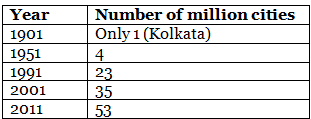
Problems created due to Rural to Urban migration
- The growth of urban slums: As people migrate from rural to urban areas, the expansion of urban slums occurs, resulting in the formation of informal settlements and pavement dwellings.
- Increased strain on public utilities: The influx of rural migrants to cities leads to overcrowded public transportation, inadequate drainage systems, encroachment on public land and roads, sanitation issues, and an increased demand for electricity.
- Cultural conflicts: The differences in lifestyles and values between long-time urban residents and newcomers from rural areas can lead to tensions and misunderstandings.
- Degradation of the urban environment: The rapid urbanization resulting from rural to urban migration can contribute to environmental problems such as the urban heat island effect, the eutrophication of city water bodies, and increased air pollution.
Seasonal Migration:
- It involves labour migration, migration to metropolitan areas and migration to religious and tourist centres.
- Labour migration from Bihar, East UP, Orissa, Jharkhand, Chhattisgarh to Punjab, Haryana, Gujarat, Maharashtra, Jammu and Kashmir and North-East India.
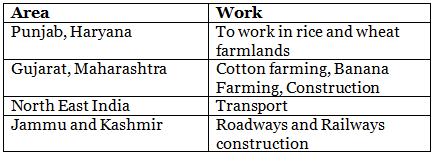
- Seasonal migration to metropolitan cities: People go here to work in construction works and footloose industry. Most of them are underemployed but better than employment in villages.
- Seasonal Migration to places of tourist interest and religious centres: This is prominent in South India and the Himalayan region. E.g. a large number of migrant labours from Eastern UP migrates to Uttarakhand hill stations in summer.
- Associated problems with seasonal migration:
- Insecurity: Migrant workers don’t have any legal support to work at these places. There are no contract papers making these migrants vulnerable to job insecurity.
- There is no social security in absence of proper identification proof.
- Improper benefits and remunerations lead to the exploitation of labour. E.g. low wages.
- Agricultural Hazards: In the agricultural belt of Punjab and Haryana the migrants are facing agricultural hazards, but due to lack of employment they are ready to take huge risks for their survival.
- Generally, the agricultural labours are SC, ST, landless labourers, BPL, etc., which creates all sorts of problems for them at the place of their destination.
- Some solution and measures:
- Temporary ration card should be issued to these migrant labours
- UWIN card: Unorganised Workers’ Identification Number or UWIN is a proposed unique number to be issued as the identity proof to unorganised workers in India for creation of a single unified sanitized database for unorganised workers to act as a platform to enable social security services to be provided to unorganised workers
- Basic amenities should be provided to these migrant labours at the place of their dwelling.
Sectoral migration
Over all internal migration is characterized by 4 streams:
- Rural to Rural (47%)
- Rural-Urban (32%)
- Urban-Urban (15%)
- Urban to Rural (6%)

Rural to Rural (47%):
- This is the most dominating migratory movement identified in the country in the 2011 Census.
- This intra-sectoral migration correlates to both intra-regional and inter-regional characteristics.
- The intra-regional perspective involves larger migratory volumes than inter-regional
- The main causes for this migration are:
- Marriage migration
- Agriculture labourers. E.g. movement of agriculture labourers from overpopulated to underpopulated areas like
(i) Movement between Awadh-Rohilkhand plains to Delta plains
(ii) Movement between Marusthali to Banas Valley (Intra-regional)
(iii) Movement between UP and Bihar to Punjab, Haryana, and Assam. - Government decisions like:
(i) Resettlement of Sikhs in Tarai region UP
(ii) In the Dandkaranya project government provided for the resettlement of 20,000 families.
Rural-Urban (32%)
- It is the second prominent migratory trend. It is inter-sectoral migration that has been the most dominating migratory trend since independence.
- It is the result of push factors in rural areas and pulls factors in urban areas. However, since 1981 census, positive effect of rural development program has resulted in easing down of push factors making this trend slump to 2nd rank.
- It involves Megacities as a destination with rural dwellers primarily from population surplus states such as UP, Bihar, MP, etc acting as source areas.
- Exponential increase in population and the number of megacities in the country is primary attributed to Rural-Urban migration.
- This migratory trend also includes intra-regional and inter-regional subcategories. E.g.:
- UP and Kerala-Intra-regional migration (i.e. migration within UP and Kerala)
- Maharashtra, NTC, Chandigarh inter-regional migration (migration from adjacent regions)
Urban-Urban (15%)
- It involves migration mainly from small towns to larger cities
- This migration involves step migration i.e. first migration takes place from rural areas to small towns and then to larger cities (Class II to Class I towns)
- Urban to Urban migration usually takes place in search of better opportunities and a better standard of living. It is dominated by people from the middle class. It creates a vacuum in small towns.
Urban to Rural (6%)
- It is a push-back or reverses migration.
- It takes place at the advanced level of urbanization when urban centers are characterized by over congestion, haphazard growth, and high cost of living.
- It is less as it involves the old age population migrating largely after the completion of their professional commitment.
- This migratory movement is technically referred to as be counter-current of migration.
Spatial trends of migration
- Migration trends in India show that Uttar Pradesh and Bihar are the largest source regions for migrants, while Gujarat, Maharashtra, and Haryana are popular destination states. This is because the National Capital Territory (NCT), Gujarat, and Maharashtra offer industrial employment opportunities, while Haryana provides agricultural jobs.
- Karnataka is another preferred destination, receiving migrants mainly from southern states, while Punjab attracts agricultural laborers. Many migrants working as domestic help come from Bengal. Peninsular states in India, being relatively distant from source regions, are considered stable areas in terms of migration.
- Historical factors contribute to migration patterns in Eastern India, such as the city of Kolkata and the industrial regions of the Damodar Valley. West Bengal, Assam, and Punjab continue to be attractive destinations for migrants. Most interstate migration occurs between states with common borders, but there are exceptions: migrants from Uttar Pradesh prefer Maharashtra, and migrants from Orissa prefer Gujarat.
- Among developed states, Kerala is the only one that doesn't attract many in-migrants and is a net source of migration. This is due to the state's limited agricultural potential, high local labor pool, and limited industrial development. A significant portion of outmigration from India to the Middle East comes from Kerala, which is often referred to as a "money order economy" due to its high remittance levels.
- Unfavorable remote locations, such as the Northern mountain wall, the Great Indian Desert, and the Rann of Kutch, serve as examples of isolated areas in terms of migration trends.
External Migration
External migration in India can be classified into:- Emigration from India to various parts of the world.
- Immigration of people from different countries to India.
- Refugee migration: There had also been a significant trend of involuntary or forced immigration to India in the form of refugees.
Emigration
Emigration during colonial rule
- In ancient times, Indian traders established bases around the Indian and the Pacific Ocean, especially in east Africa and western and Southeast Asia. However, those flows were not the basis for Indian migration in the 19th century or the global dispersion seen today.
- In 1834, Britain began exporting Indian labour to Mauritius. The Netherlands and France, which replicated the British system, also relied on Indian workers. By 1878, Indians were working in Guyana, Trinidad, Natal (South Africa), Suriname, and Fiji.
Emigration on the eve of independence
- The partition led to an enormous migration of people which is estimated at between 12 and 18 million that took place from 1947 to 1950. About half of the migrants (mainly Muslims) moved from India to Pakistan and half (mainly Hindus and Sikhs) moved in the opposite direction.
(i) This two-way migration was accompanied by server violence between caravans of migrants and in the respective source regions. Estimates of the death toll during this period range between 200,000 and 1 million.
(ii) During the war in East Pakistan, in 1971, which lead to the formation of Bangladesh, around 10 million refugees (80% of them Hindu) crossed the border into India of which an estimated 35,000 remained in India.
Post-independence emigration
- The Supreme Court established the “right to travel” as a fundamental right under the Indian constitution, following which the Indian parliament enacted the Passports Act of 1967.
- In the first decades after independence, unskilled, skilled, and professional workers (mostly male Punjabi Sikhs) migrated from India to the United Kingdom. This is commonly attributed to Britain’s post-war demand for low-skilled labour, postcolonial ties, and the United Kingdom’s commonwealth immigration policy, which allowed any citizen of a commonwealth country to live, work, vote, and hold public office in the United Kingdom.
Current scenario of emigration
- The top three countries of origin of international migrants – India (17.5 million)> Mexico (11.8 million)> China (10.7 million).
- The top three remittance recipients were India ($78.6 billion)> china ($67.4 billion)> Mexico ($35.7 billion).
- The United States remained the top remittance-sending country ($68 billion) followed by the United Arab Emirates ($44.4 billion) and Saudi Arabia ($36.1 billion).
Immigration
- Immigration is the process by which individuals become permanent residents or citizens of another country. This process has historically provided significant social, economic, and cultural benefits to various nations. According to the International Migrant Stock 2019 report by the United Nations Department of Economic and Social Affairs (UNDESA), India has become the leading country of origin for immigrants worldwide.
- The report presents the most recent estimates of the number of international migrants, including information on their age, gender, and country of origin for every nation and region in the world. India held the top position as the source of international migrants, accounting for 6.4% of the world's total migrant population.
- The most popular destination for Indian migrants was the United Arab Emirates, followed by the United States and Saudi Arabia. In India, the largest number of international migrants came from Bangladesh, Pakistan, and Nepal. One-third of all international migrants originated from just ten countries.
- India, with 17.5 million international migrants, was followed by Mexico (12 million), China (11 million), Russia (10 million), and Syria (8 million) in terms of the number of migrants originating from these countries.
Refugee Migration
- A refugee is described as a person who, due to a well-founded fear of persecution based on race, religion, nationality, social group membership, or political opinion, is residing outside their country of nationality. Refugees do not change their nationality upon leaving their home country, such as Tibetan refugees in India.
- One example of refugee migration occurred during the partition between India and Pakistan, where people crossed the new borders without losing their nationalities. Another example is the Tibetan refugees who settled across northern and northeastern India, where the Dalai Lama, the spiritual and political leader of the Tibetan community, also resides.
- Another significant refugee crisis occurred during Bangladesh's war of independence in 1971. Millions of refugees fled from the country to India to escape the conflict between the Pakistani army. Additionally, Sri Lankan Tamils make up a substantial group of refugees in India, having left their home country due to discriminatory policies, events like the Black July Riots in 1983, and the Sri Lankan civil war.
- The topic of refugees has recently gained national attention in India as 40,000 Rohingya Muslims sought shelter in the country after fleeing Myanmar. The UNNHRC has issued identity cards to approximately 16,500 Rohingya in India.
International Migration
India has not always been significantly impacted by in-migration. However, several historical events have led to a noticeable influx of international migrants into the country, such as:(i) Partition (1947-51):
(a) During the partition, India saw an influx of approximately 7.3 million refugees, although there was also a substantial out-migration at the same time.
(b) Hindus and Sikhs migrated to India, while Muslims migrated to Pakistan.
(c) These migrants settled in urban areas, suburban refugee colonies, and the Tarai belts of Uttar Pradesh.
(d) Rather than creating social problems, these migrants have contributed to the growth of the country.
(ii) Buddhist Migration (1954-59): Around 100,000 Tibetan refugees settled in Dharamshala, Himachal Pradesh.
(iii) Liberation of Bangladesh (1971): The movement initiated by Mukti Bahini led to the arrival of approximately 10 million people in India. There is no other recorded instance in history where one country provided food for ten million people for eight months.
(iv) Tamil migrants: During colonial times, a large number of Tamils migrated to Jaffna and the North-East province of Sri Lanka. This led to the development of grievances with local residents and eventually resulted in militancy. The operations against Tamil militants by the government led to the migration of Tamils to India.
(v) Current times: People from various countries, such as those from SAARC and African nations, come to India for education, business, and other purposes, often through scholarship programs.
(vi) Geopolitical crisis: Due to the unstable political situation in Gulf countries like Yemen, Syria, and Iraq, people of Indian origin living in these areas are returning to India.

Out-migration before independence:
Indian out-migration began during the colonial era, primarily after the abolition of the slave trade in 1833. The resulting labor shortage led to Indian migration from regions such as Uttar Pradesh and Bihar to countries like the Philippines and Java in Indonesia for plantation agriculture.
Labour migration occurred mainly in the following patterns:
- From eastern Uttar Pradesh and Bihar to Central America and Mauritius for plantation agriculture.
- From western Uttar Pradesh and Punjab to Fiji.
- From Tamil Nadu to Malaysia for rubber plantations.
- These migrations mainly involved upper-class individuals and targeted agricultural areas unsuitable for European settlers.
Passage migration comprised of:
- Indian migration to Hong Kong, Kenya, Singapore, and Uganda.
- This migration was well-organized and structured.
- The source areas included Gujarat (Gujarati and Sindhi), Maharashtra, Punjab, Tamil Nadu, and Andhra Pradesh, with migrants eventually settling permanently in these locations.
- Later passage migration extended to South Africa and New Zealand.
Out-migration after independence:
- Brain drain migration involved the migration of highly skilled professionals, primarily to the USA, Canada, and some European countries. In the USA, Indian migrants have higher average incomes compared to the general population, with an average income of $60,000 (and $120,000 in Silicon Valley). In Canada, a significant number of Sikhs work in the Prairie provinces.
- Labour migration post-independence has been mainly directed towards Gulf countries. After the Arab-Israel war of 1972-73 and the subsequent oil crisis, there was an increase in petroleum production in Gulf countries, leading to a surge in Indian labor migration. Currently, around 7 million Indians are working in Gulf countries, contributing to significant remittance inflows.
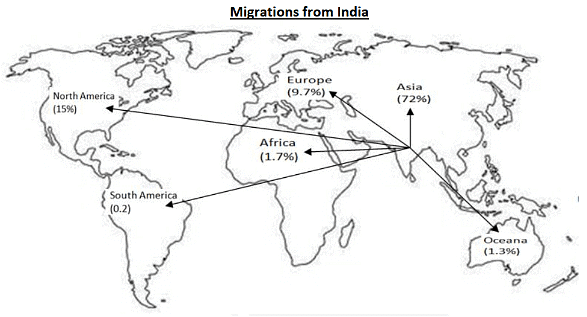
Countries where Indian Population is Substantial

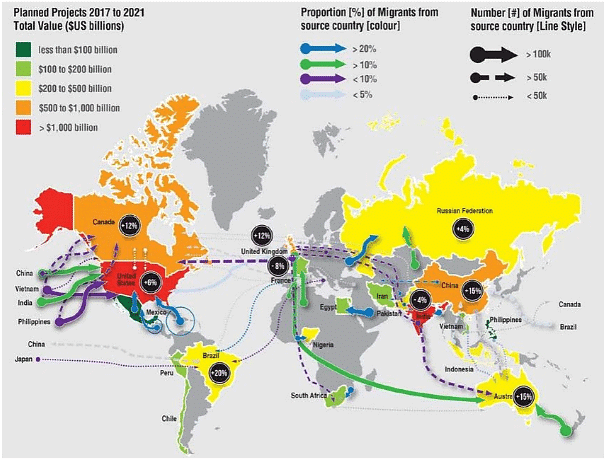 International migration
International migration
 Map of major South Asian migration flows
Map of major South Asian migration flows
Conclusion
In conclusion, migration in India is a significant phenomenon driven by various factors such as economic opportunities, marriage, education, and political reasons. The majority of migration is internal, with rural-urban migration being a key trend. Interstate and inter-regional migration also play a role in shaping the socio-economic landscape of the country. External migration, both emigration and immigration, has historical roots in the colonial era and continues to impact the nation in the present day through labor migration and refugee influx. Understanding these migration patterns and their implications is crucial for policymakers and social planners in addressing the challenges and harnessing the benefits that migration brings to India.Frequently Asked Questions (FAQs) of Migration (Inter-Regional, Intraregional & International) & Associated Problems
What is the main cause of migration in India?
The main cause of migration in India is economic, with people moving for reasons such as business, work and employment, marriage, moving with families, political reasons, and education.
What are the different types of internal migration in India?
Internal migration in India can be classified into long-term migration, where an individual or household relocates permanently, and short-term migration, which involves temporary back-and-forth movement between the origin and destination.
Which states in India are major sources and destinations for internal migration?
Major source states for internal migration in India include Uttar Pradesh, Bihar, Rajasthan, Madhya Pradesh, Andhra Pradesh, and Chhattisgarh, while popular destination states are Delhi, Maharashtra, Gujarat, Haryana, Punjab, and Karnataka.
What are some problems created due to rural to urban migration in India?
Problems created due to rural to urban migration include the growth of urban slums, increased strain on public utilities, cultural conflicts, and degradation of the urban environment.
What are the main trends in external migration from India?
External migration from India includes emigration during colonial rule, emigration on the eve of independence, post-independence emigration, immigration, refugee migration, and international migration. Current trends show that India is the leading country of origin for immigrants worldwide.
|
303 videos|636 docs|252 tests
|





















